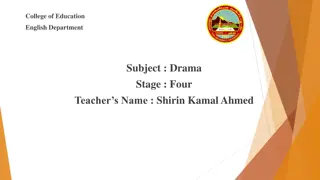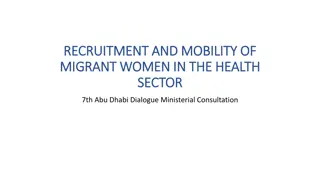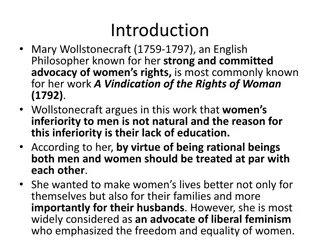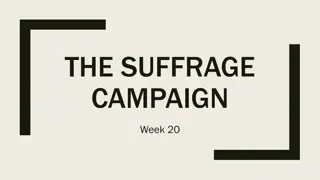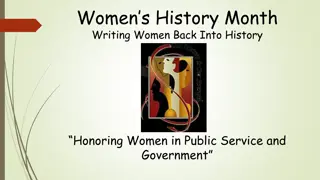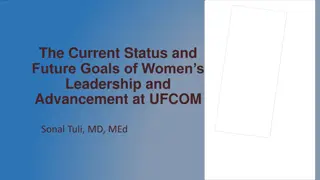Women's Role in the 1916 Easter Rising
Women played crucial roles in the 1916 Easter Rising in Ireland as members of the Irish Citizen Army and Cumann na mBan. They were involved in activities like transporting messages, distributing food, and providing first aid. Countess Markievicz, a prominent figure, was second-in-command in St. Stephen's Green/RCSI garrison. The women faced challenges and contributed significantly to the rebellion despite facing imprisonment and court-martial.
Download Presentation

Please find below an Image/Link to download the presentation.
The content on the website is provided AS IS for your information and personal use only. It may not be sold, licensed, or shared on other websites without obtaining consent from the author. Download presentation by click this link. If you encounter any issues during the download, it is possible that the publisher has removed the file from their server.
E N D
Presentation Transcript
WOMEN AND THE 1916 RISING
Who? Where? Women who took part in the Rising were members of either the Irish Citizen Army or Cumann na mBan. The Citizen Army women were mostly stationed in St. Stephen s Green/RCSI and City Hall. James Connolly was a feminist he believed women should be treated equally - so the women in the Irish Citizen Army played a more active part in the Rising than those in Cumann na mBan. A large number of Cumann na mBan members were in the Marrowbone Lane garrison, but were represented in many others, including the Four Courts, Jacobs and the GPO.
What role did women play in the Easter Rising? Transported messages Carried ammunitions Distributed food to the garrisons Cooked food for the rebels Assisted the injured Fought
First Aid Training Response Death The women in Cumann na mBan and the Irish Citizen Army had been trained in first aid before the Rising many by Dr. Kathleen Lynn. Margaretta Keogh, a nurse, was the first woman killed in the Rising. She was shot accidentally when she ran to help an injured man beside the South Dublin Union garrison. 45 women and 9 girls were killed during the Rising. Each garrison had a First Aid station. Madeline Ffrench-Mullen was in charge of first aid in St. Stephen s Green, where the bandstand was used as a first aid station.
Food Nellie Gifford made porridge in the RCSI which Countess Markievicz thought was delicious . Helena Molony made porridge in City Hall with oats she found there. The rebels in the Jacobs Factory had lots of biscuits and crackers to feast on. In Marrowbone Lane, a calf was killed by one of the men who was a butcher. In the Four Courts, the women had to re-use turnip water from dinner to make cups of tea! Porridge was a staple in many garrisons When a message was sent to the GPO that the rebels in the RCSI were short of food, James Connolly gave Julia Grennan and Elizabeth O Farrell 1 to buy cheese, bread and Oxo cubes for their comrades in the RCSI.
So, who were some of the women who took part in the Easter Rising?
Countess Markievicz Constance Gore-Booth grew up in an Anglo-Irish family in Co. Sligo. She married Casimir Markievicz, a Polish Count, and became known as Countess Markievicz. Markievicz was a lieutenant in the Irish Citizen Army. She was second- in-command to Michael Mallin in the St. Stephen s Green/RCSI garrison. On Tuesday, the rebels moved to the RCSI because the Green was unsafe as it was overlooked by the Shelbourne Hotel After the Rising, Markievicz was held in solitary confinement in Kilmainham Gaol and was the only woman to be court martialled after the Rising. She was sentenced to death but this sentence was commuted to life imprisonment because she was a woman. Markievicz was transferred to Aylebury Prison, UK where she remained until July 1917, when the Irish rebels were all released.
Rosie Hackett In 1911, Rosie organised a strike in the Jacob s factory to attempt to get better conditions for the women working there and was a founding member of the Irish Women Workers Union. She was a member of the Irish Citizen Army and worked in the shop in Liberty Hall. On the eve of the Rising, Rosie carried copies of the freshly printed Proclamation back and forth between the print room and James Connolly s office for inspection. Rosie Hackett was stationed at St. Stephen s Green/RCSI during the Rising. Afterwards, Rosie was taken to Richmond Barracks in Inchicore, before being taken to Kilmainham Gaol, where she was released on 8 May 1916.
Margaret Skinnider http://www.glasnevintrust.ie/_internal/cimg!0/3s87s7a85pnejipge2415tguxgj66g4 Margaret Skinnider was a Scottish Maths teacher, who also organised the Glasgow branch of Cumann na mBan. Skinnider travelled to Ireland for the Easter Rising and joined the Stephen s Green/RCSI garrison, where she was a sniper. Margaret Skinnider was badly injured during Easter Week. She was shot four times and had to be carried out of the RCSI She spent 7 weeks recovering from her injuries in St. Vincent s Hospital and avoided arrest as a result of her hospitalisation. In the 1950s, Margaret became President of the Irish National Teachers Organisation (INTO).
Dr. Kathleen Lynn Dr. Kathleen Lynn was born into a Protestant family in Co. Mayo. She became one of the first women doctors in Ireland. Lynn was appointed a Captain in the Irish Citizen Army, where she trained its members in First Aid. Kathleen Lynn was stationed at City Hall during the Rising. Its commandant Se n Connolly was the first rebel to be killed in the Rising so Dr. Lynn took charge of the garrison She was taken to Ship St Barracks, Richmond Barracks and then Kilmainham Gaol. Lynn was sent to work in a GP practice in the UK in lieu of a jail sentence as Britain was short on doctors because of WW1.
Helena Molony http://static1.squarespace.com/static/550c57a4e4b0ead0d0493b11/t/557f0c6de4b0ff7f4a6daed5/1434389625855/helena-moloney-maud-gonne-1916 Helena Molony was a successful actress in the Abbey Theatre and a member of the Irish Citizen Army. On the eve of the Rising, Molony slept on copies of the Proclamation, to keep them safe in the backroom of Liberty Hall. During the Rising, Molony was stationed at City Hall with Dr. Kathleen Lynn. Upon arrest, Helena was sent to Ship St Barracks, Richmond Barracks, Kilmainham Gaol and then to Lewes Prison in the UK before finally being sent to Aylesbury Prison where she was jailed alongside her friend Constance Markievicz.
Elizabeth O Farrell Early on Easter Monday morning 1916, Elizabeth O Farrell travelled to Athenry, Co. Galway to let the rebels there know the Rising was due to start in Dublin at noon. She returned to the GPO, where she was stationed with her friend Julia Grennan. Elizabeth O Farrell famously carried the surrender note up Moore St to General Lowe of the British Army. Lowe asked O Farrell to carry the note around every garrison a dangerous job which took her two days to alert all of the rebels that the leadership had surrendered. Because she delivered the surrender, O Farrell was given an amnesty and avoided a jail sentence after the Rising.
Easter Widows Some of the women who did not take part in the Rising but suffered as a result of it
Kathleen Clarke Kathleen s husband Tom Clarke was head of the Irish Republican Brotherhood who organised the Rising. Kathleen did not take part in the Rising because she was Tom s ghost he gave her secret IRB information and money in case he didn t survive the rebellion. Kathleen s husband Tom and her brother Edward (Ned) Daly were both executed after the Rising. Kathleen was pregnant and lost her baby shortly after. After the Rising Kathleen hired a young man named Michael Collins to take charge of the IRB money.
Hanna Sheehy Skeffington Hanna Sheehy Skeffington and her husband Francis were pacifists. This meant they did not believe in violence, so neither of them took part in the Rising. Hanna dropped tins of soup and salmon in to the hungry rebels in the RCSI. Francis tried to stop the looting which had broken out in the city. He was arrested and killed for no reason in Portobello Barracks. Hanna went to the US on a speaking tour in 1917 to highlight the injustice of his killing by the British Army.
Aftermath 77 women were arrested after the Rising and taken to Richmond Barracks in Inchicore Many were then transferred to Kilmainham Gaol, where Countess Markievicz was the only prisoner held in solitary confinement because of her high profile role in the Rising. On 8th May 1916, all of the women were released except the 12 women the authorities considered most dangerous (including Molony, Lynn and Markievicz). Women played an important role after the 1916 Rising, as many of the men were in jail and 16 had been executed. Cumann na mBan became a more important and more active organisation after the 1916 Rising.
Did you know? Eamon de Valera (later Taoiseach and President of Ireland) as commandant of Boland s Mills, was the only leader who refused to allow any women in a garrison during the Rising. Nellie Gifford collected a large number of artefacts, documents and photos from the Rising which form a large part of the National Museum of Ireland s 1916 collection today. The separation women , those who were angry that their money was cut off during the Rising made fun of Countess Markievicz as she marched to Kilmainham Gaol because she was wearing trousers! Nellie s sister Grace Gifford married Joseph Plunkett in a ceremony in the small chapel in Kilmainham Gaol only hours before he was executed.
Further links Rosie Hackett ballad https://www.youtube.com/watch?v=TxqEGPBPxKA http://www.richmondbarracks.ie/women-1916






